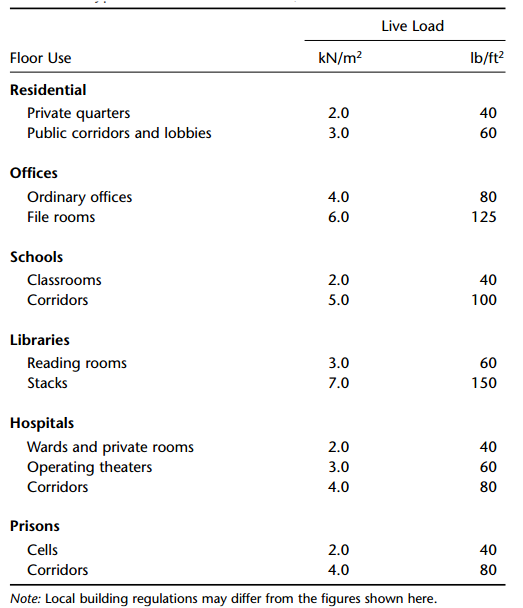Non-Industrial Floors
This category includes all floors except warehouse and factory floors. Though non-industrial floors get little attention, they are actually far more numerous than their industrial counterparts.
Non-industrial floors are usually easier to design and build than industrial floors, for three reasons:
- First, they generally support very light loads.
- Second, few of these floors are subject to wheeled traffic.
- Third, most non-industrial concrete floors are concealed beneath floorcoverings such as carpet, tile or resilient flooring.
Non-industrial floors can be divided into the following categories:
- residential floors;
- office floors;
- floors for retail trade;
- institutional floors.
1- Residential floors
These are found in private houses and multiple dwellings. They are characterized by short spans, light loads, and foot traffic. Nearly all residential floors are concealed by carpet, tile, sheet material or wood. This is the only category of floor use in which concrete faces serious competition as a structural material. Suspended timber floors are common in houses, and outnumber concrete floors in many countries.
Loading
Residential floors support a variety of loads from occupants, furniture, partition walls and appliances. Most loads are very light compared to those found in industrial buildings.
Designers seldom even consider loads when planning ground-supported residential floors. Such floors are usually designed to a standard thickness without regard to specific loading. A 100 mm slab is usual, and will suffice on all but the worst sites.
Suspended residential floors are often designed for a nominal live load of about 2.0 kN/m2. See Table 1. Local building regulations may require a different figure.
Table 1: Typical live loads for residential, office and institutional floors
Joint and crack requirements
Joints and cracks seldom create much trouble in residential construction, because the concrete slabs are usually concealed. Stress-relief joints are seldom needed, except for isolation joints to separate a ground-supported floor from fixed objects. Construction joints may be used, but many residential floors are small enough to be laid without them.
Most residential floors are covered, but there are a few exceptions – in garages, for example – where the concrete slab is exposed to view. In such situations the designer may wish to use stress-relief joints to reduce the risk of unsightly cracks.
Cracks in a residential floor rarely need sealing or repair unless they are so wide that they would show through a floorcovering.
2- Office floors
With a few exceptions, office floors are similar to residential floors, though they sometimes support heavier loads. Most of the preceding discussion of residential floors applies equally to office floors.
Loading
Office floors are typically designed to support live loads of about 4.0 kN/m2 (see Table 1). Heavier loads may be found in file rooms.
Joint and crack requirements
Office floors have no special requirements for joint and cracks. Surface requirements Office usage demands little of the concrete floor surface. Office floors are almost invariably concealed by carpet or thin sheet material.
3- Floors for the retail trade
This category covers a wide range of buildings, from small local shops to hypermarkets to do-it-yourself stores. Floors in small and medium-sized shops are usually concealed. They are similar to office floors and are designed and built in the same way. At the other extreme, floors in big do-it-yourself stores are functionally the same as warehouse floors and should be designed as such.
Loading
Retail floors often support heavier loads than residential and office floors. The user may be able to provide specific information. Lacking that, designers typically assume a live load of about 7.0 kN/m2. Certain trades impose much lighter loads, but it is unwise to base the design on them because future occupants may be in a completely different line of business.
4- Institutional floors
This category includes floors in schools, libraries, hospitals and other public buildings. These floors are characterized by heavy foot traffic, but Floors may have little else in common. Many institutional floors are concealed, but direct-finished concrete is also used.
Loading
Table 1 shows typical design loads for some types of institutional floors. Local building regulations usually dictate the loads for which these floors are designed.
Joint and crack requirements
If an institutional floor will be covered, the joint and crack requirements are the same as for residential and office floors. Some institutional floors are made of direct-finished concrete, however. Cracks in such floors rarely affect usability, but may nevertheless be highly objectionable to the users. For that reason, crack control may be very important – even more important than in the typical industrial floor.
Special considerations
Some institutional floors, particularly those in public buildings such as courthouses, railway stations and airport terminals, must combine structural strength, wear resistance and architectural effect. That is an unusual combination in a concrete floor, but it can be achieved.
There is no single solution to the problem, because much depends on how the designer wants the floor to look. Many designers use terrazzo toppings for these floors. Other designers have used colored concrete, concrete with stamped patterns or stains.

